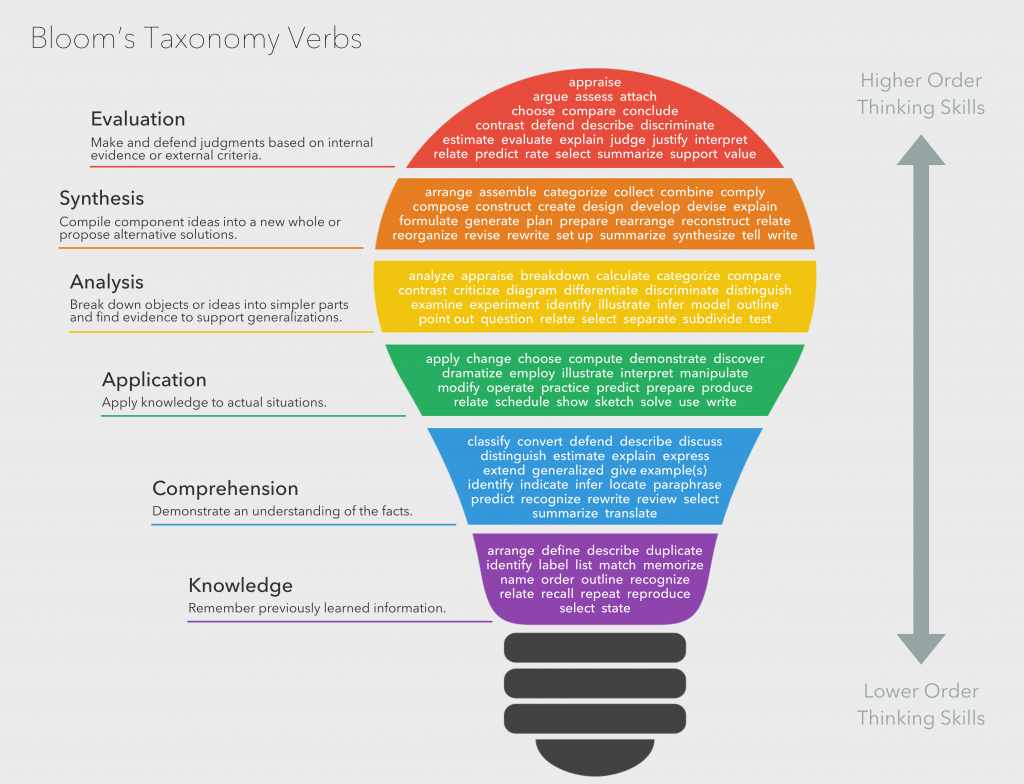Bloom’s Taxonomy
Introduction
The Bloom Taxonomy was developed in the 1950s by Benjamin Bloom, an educational psychologist. It helps to differentiate increasingly complex levels of student learning, and therefore marks out higher order thinking and learning from simpler tasks such as rote memorisation.
Other similar taxonomies have been developed, such as the SOLO taxonomy (which is a little simpler and easier to tie to a single learning outcome or learning activity). Many developments of Bloom’s taxonomy have been proposed, including direct ‘improvements’ to the taxonomy and developments of other systems that similarly differentiate learning and attainment. However, we will stick to just one version here.
The full taxonomy
The full taxonomy is actually based around three domains – cognitive, affective (emotion based) and psychomotor (action based). Each of these domains has a taxonomy ranking the complexity of student attainment within that domain. However, by far the best known is the cognitive domain. The levels are traditionally depicted with the lower order skills at the bottom, and the higher order skills at the top, as seen below in this image of the cognitive domain of Bloom’s Taxonomy.

The relevant learning is listed for the three domains below, starting from the lowest order of learning, up to the highest.
The cognitive domain
- Remembering – key information is memorised
- Understanding – comprehension may be demonstrated by describing, organising or interpreting
- Applying – using acquired knowledge in a new situation
- Analysing – examining and breaking down information into component parts and identifying relationships between those parts
- Synthesising – creating new material, putting together distinct ideas to create a coherent whole
- Evaluating – presenting and defending opinions about information, criticality
The affective domain
- Receiving – passively paying attention
- Responding – active participation
- Valuing – value is assigned to a piece of learning
- Organising – different pieces of learning can be structured and linked within a schema
- Characterising – abstract knowledge is built
The psychomotor domain
- Perception – the use of sensory cues to guide motor activity
- Set – readiness to act
- Guided response – imitation, trial and error, practice is needed
- Mechanism – the action has become habitual and can be performed with some confidence and accuracy
- Complex overt response – skilful performance of complex motor patterns
- Adaptation – learned responses can be modified for different situations
- Origination – new movement patterns can be created in response to complex situations
References and further reading
Bloom, B. S., Engelhart, M. D., Furst, E. J., Hill, W. H., Krathwohl, D. R. (1956) Taxonomy of educational objectives: The classification of educational goals. Handbook I: Cognitive domain. New York: David McKay Company.
Bloom, B. S. (1994). “Reflections on the development and use of the taxonomy”. In Rehage, Kenneth J.; Anderson, Lorin W.; Sosniak, Lauren A. Bloom’s taxonomy: A forty-year retrospective. Yearbook of the National Society for the Study of Education. 93. Chicago: National Society for the Study of Education.

[…] This taxonomy was proposed by John B. Biggs and K. Collis. A similar way of approaching the complexity of student learning is Bloom’s taxonomy. […]
[…] learning. We all know about the desirable verbs for learning outcomes, and can match them to Bloom’s taxonomy. We use these same specific terms to create clarity and comparability across learning experiences, […]